Related Research Articles
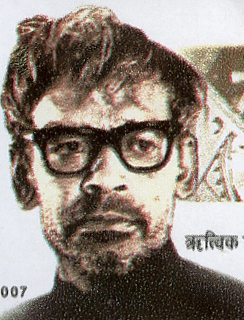
Ritwik Kumar Ghatak was a noted Indian film director, screenwriter, and playwright. Along with prominent contemporary Bengali filmmakers Satyajit Ray, Tapan Sinha and Mrinal Sen, his cinema is primarily remembered for its meticulous depiction of social reality, partition and feminism. He won the National Film Award's Rajat Kamal Award for Best Story in 1974 for his Jukti Takko Aar Gappo and Best Director's Award from Bangladesh Cine Journalist's Association for Titash Ekti Nadir Naam. The Government of India honoured him with the Padma Shri for Arts in 1970.
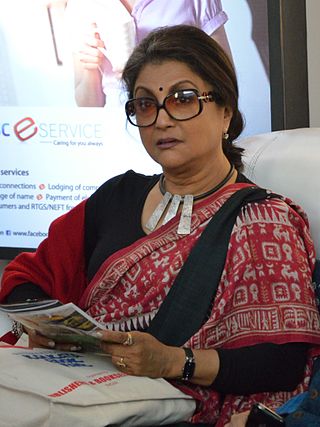
Aparna Sen is an Indian film director, screenwriter and actress who is known for her work in Bengali cinema. She has received several accolades as an actress and filmmaker, including nine National Film Awards, five Filmfare Awards and thirteen Bengal Film Journalists' Association Awards. For her contribution in the field of arts, the Government of India honoured her with Padma Shri, the country's fourth highest civilian award.

Riya Sen is an Indian actress and model who predominantly appears in Hindi, Bengali, English, Telugu and Tamil films.

Pramathesh Chandra Barua was an Indian actor, director, and screenwriter of Indian films in the pre-independence era, born in Gauripur, Dhubri, Assam.

Mani Shankar Mukherjee is an Indian writer in the Bengali language, who also served as the Sheriff of Kolkata. He grew up in Howrah district of West Bengal.
Parallel cinema, or New Indian Cinema, is a film movement in Indian cinema that originated in the state of West Bengal in the 1950s as an alternative to the mainstream commercial Indian cinema.

The culture of West Bengal is an Indian culture which has its roots in Bengali literature, music, fine arts, drama and cinema. Different geographic regions of West Bengal have subtle as well as more pronounced variations between each other, with Darjeeling Himalayan hill region and Duars showing particularly different socio-cultural aspects.

Nagarik, also spelled as Nagorik, was the first feature-length film directed by legendary Indian director Ritwik Ghatak. Completed in 1952, it preceded Satyajit Ray's Pather Panchali as perhaps the first example of an art film in Bengali cinema, but is deprived of that honor, since it was released twenty-four years later, after Ghatak's death. On 20 September 1977, it finally premiered at the New Empire theatre in Kolkata, India. Ritwik Ghatak directed only eight feature films, but is generally regarded as one of the auteurs of Indian cinema and virtually unsurpassed as a creator of powerful imagery and epic style by directors such as Satyajit Ray and of transcendental power and extraordinariness by critics such as Derek Malcolm.
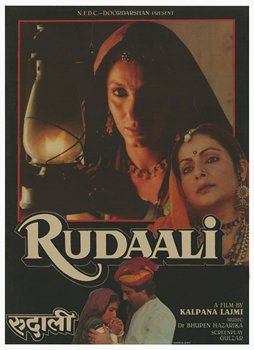
Rudaali is a 1993 Indian Hindi-language drama film directed by Kalpana Lajmi, written by Lajmi and Gulzar and based on a 1979 short story of the same name by Bengali author Mahasweta Devi. Set in a small village in Rajasthan, the film stars Dimple Kapadia as Shanichari, a lonely and hardened woman who, despite a lifetime of misfortune and abandonment, is unable to express grief through crying and is challenged with a new job as a professional mourner. Raakhee, Raj Babbar, and Amjad Khan appear in supporting roles. Produced by the National Film Development Corporation of India and Doordarshan, the film was labelled part of India's neo-realist parallel cinema, but it employed several of the common elements of mainstream Hindi cinema, including songs composed by Bhupen Hazarika.
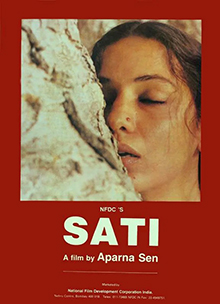
Sati is a Bengali film released in 1989 written and directed by Aparna Sen. Based on a story by Kamal Kumar Majumdar, the film is about mute orphan girl who is married to a Banyan tree because her horoscope suggests that she would be a sati, and her husband would die. The film had Shabana Azmi and Arun Banerjee in lead roles.

Cinema of West Bengal, also known as Bengali cinema or Tollywood, is an Indian film industry of Bengali-language motion pictures. It is based in the Tollygunge region of Kolkata, West Bengal, India. The origins of the nickname Tollywood, a portmanteau of the words Tollygunge and Hollywood, dates back to 1932. It was a historically important film industry, at one time the centre of Indian film production. The Bengali film industry is known for producing many of Indian cinema's most critically acclaimed global Parallel Cinema and art films, with several of its filmmakers gaining prominence at the Indian National Film Awards as well as international acclaim.

Komal Gandhar, also known as A Soft Note on a Sharp Scale, is a 1961 Bengali film written and directed by legendary film maker Ritwik Ghatak. The title refers to the Hindustani equivalent of "E-flat". It was part of the trilogy composed of Meghe Dhaka Tara (1960), Komal Gandhar and Subarnarekha (1962), all dealing with the aftermath of the Partition of India in 1947 and the refugees coping with it, though this was the most optimistic film of his oeuvre. The film explores three themes juxtaposed in the narrative: the dilemma of Anusuya, the lead character, the divided leadership of IPTA, and the fallout from the partition of India.

Amar Lenin is a 1970 black and white documentary film directed by film director Ritwik Ghatak made for Government of West Bengal in the centenary year (1970) of the birth of Vladimir Lenin.

Nilkantha Bagchi is an iconic Bengali cinema character that first appeared in 1977 in Ritwik Ghatak's Jukti Takko Aar Gappo. In the 2013 film Meghe Dhaka Tara, the character portrayed by Saswata Chatterjee was named Nilkantha Bagchi. Chatterjee's character was based on the personality of Ritwik Ghatak.
Mujhe Budhha Mil Gaya is a Hindi film song by Lata Mangeshkar. It featured in the 1964 Hindi film Sangam produced, directed by Raj Kapoor.

This article contains a list of books about Hindi film director and actor Raj Kapoor.
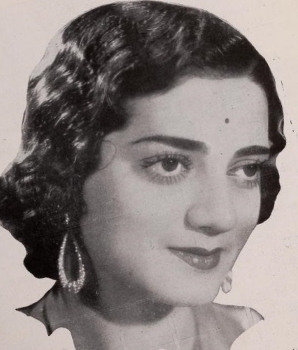
Sabita Devi (1914–1965) was a Hindi film actress in Indian cinema. She is stated to be one of the "prominent" leading ladies of the "pioneering era" of Indian cinema along with Mehtab, Bibbo, Durga Khote, Gohar, Devika Rani and Seeta Devi. A Jewess by birth, she changed her name to find acceptability in Hindi cinema like the other Anglo-Indian and Jewish actresses of her time, Sulochana, Seeta Devi, Madhuri, and Manorama. After initially working with British Dominion Films Ltd., Calcutta, she shifted to Bombay and performed mainly in films produced by Sagar Movietone with her co-star in most films being Motilal. Some of the popular films with Motilal were Dr. Madhurika (1935) and Kulvadhu (1937) directed by Sarvottam Badami. Their first film together was Shaher Ka Jadoo (1934), which was also Motilal's debut film, and then Lagna Bandhan (1936) both directed by Kaliprasad Ghosh. She acted in Silver King (1935) with Motilal. It was an action film directed by C. M. Luhar, which became a "huge success".
Rittika Sen is an Indian actress who appears in Bengali and Tamil films. She was featured in the Calcutta Times list of Most Desirable Women 2015.
References
- 1 2 3 4 "Chatterji, Shoma". SAGE Publications Inc . 21 November 2020.
- 1 2 Gokulsing, K. Moti; Dissanayake, Wimal, eds. (2013). Routledge Handbook on Indian Cinema. Routledge. pp. xi. ISBN 9781138311480.
- 1 2 "50th National Film Awards" (PDF). Directorate of Film Festivals. p. 121. Archived from the original (PDF) on 3 March 2016. Retrieved 14 March 2012.
- ↑ Mukherjee, Rina (29 January 2014). "Shoma Chatterji wins National Award for best author – NWM India". Network of Women in Media, India. Retrieved 22 November 2020.
- 1 2 Chowdhury, Nandita (23 August 1999). "Author Shoma Chatterji tracks the woman in Indian films". India Today . Retrieved 22 November 2020.
- ↑ "38th National Film Awards" (PDF). Directorate of Film Festivals. pp. 116–117. Archived from the original (PDF) on 15 December 2017. Retrieved 9 January 2012.
- 1 2 3 4 "Live Encounters Magazine September 2017". Issuu . pp. 6–7. Retrieved 2 December 2020.